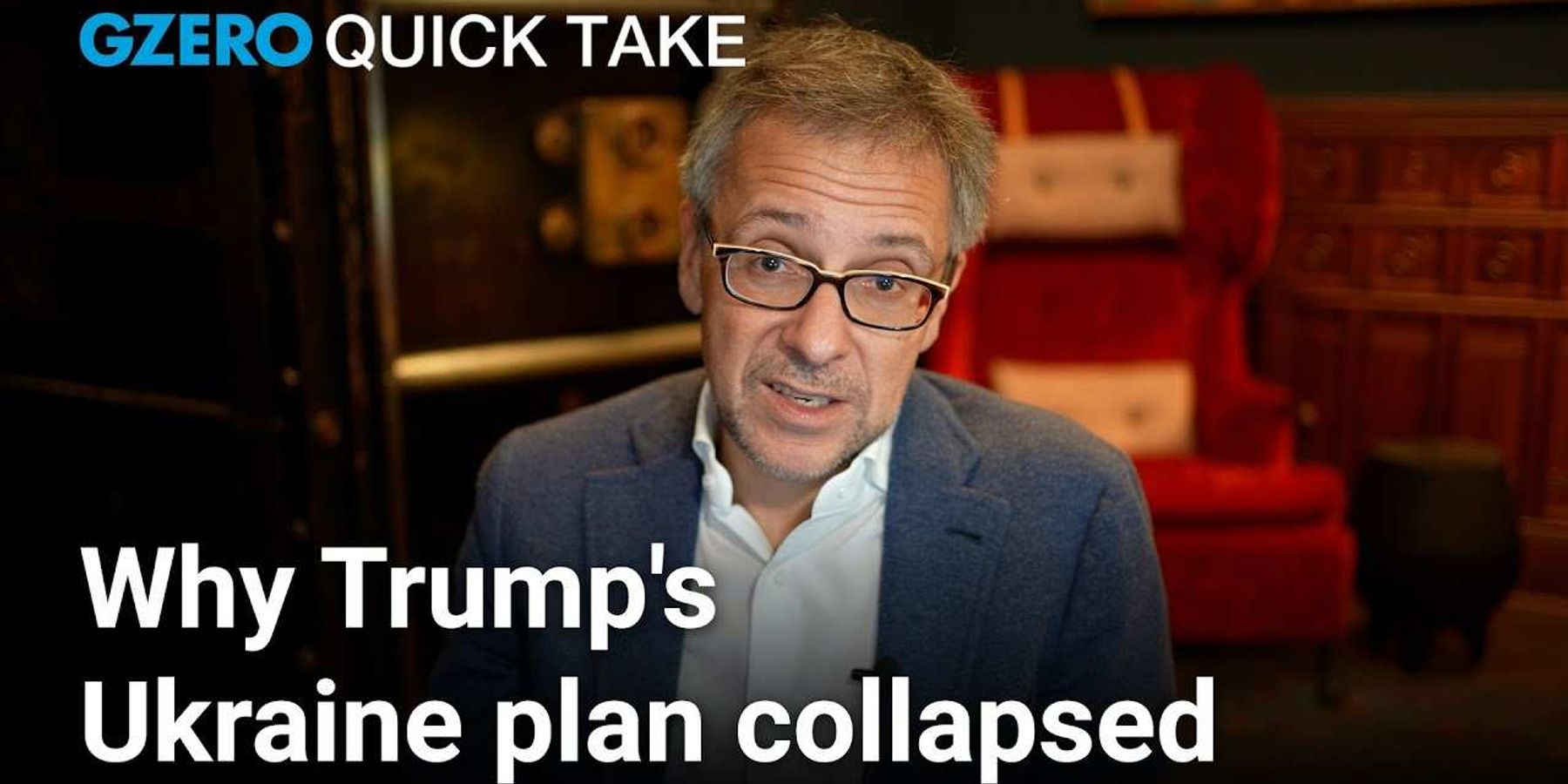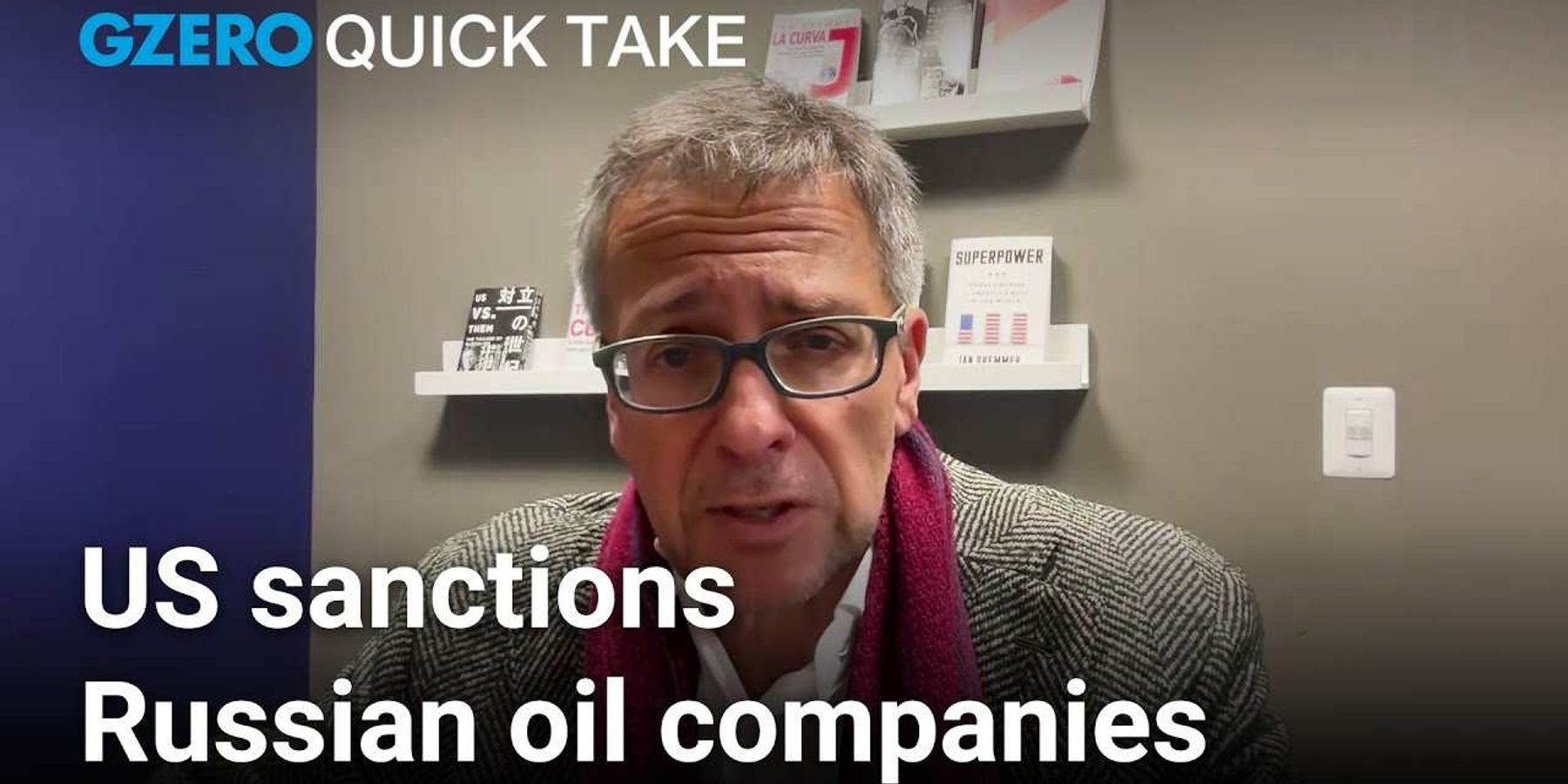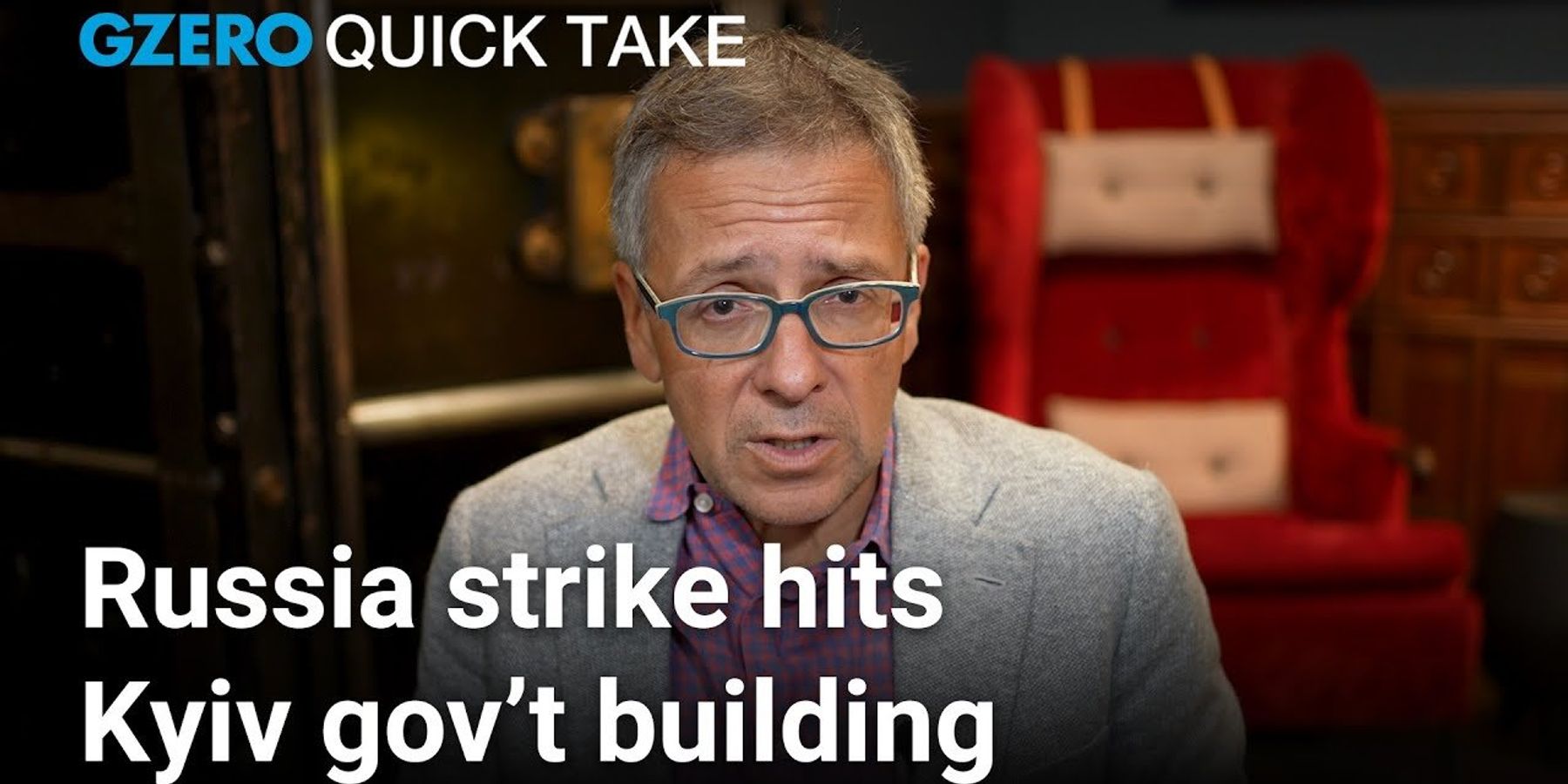Trending Now
We have updated our Privacy Policy and Terms of Use for Eurasia Group and its affiliates, including GZERO Media, to clarify the types of data we collect, how we collect it, how we use data and with whom we share data. By using our website you consent to our Terms and Conditions and Privacy Policy, including the transfer of your personal data to the United States from your country of residence, and our use of cookies described in our Cookie Policy.
{{ subpage.title }}
Europe divided as US pushes Ukraine-Russia peace deal
In this Quick Take, Ian Bremmer breaks down the controversy around Trump's 28-point Ukraine-Russia peace plan.
He says the proposal was “mostly drafted by the Russians” and loaded with “complete non-starters” for Ukraine, from ceding more territory to reducing troop levels and granting blanket amnesty for war crimes.
Ian explains that while allies publicly “appreciate the American effort,” he notes that few are buying the plan’s substance. With Europe divided and Russia sensing momentum, he warns that “the war is not close to over,” and that the next phase will likely be shaped by battlefield realities, not diplomacy.
Ukrainian President Volodymyr Zelensky meets with US Army Secretary Daniel Driscoll amid Russia's attack on Ukraine, in Kyiv, Ukraine, on November 20, 2025.
What We’re Watching: Kyiv gets a nugget US peace plan, Election day in Guinea-Bissau, Two men from Queens meet at the White House
A nugget for Kyiv in the US plan for ending the war
The United States’ 28-point plan for ending the war in Ukraine appears to contain many items from Russia’s wish list, but it has emerged that it also has something for Kyiv: a security guarantee akin to NATO’s Article 5, which says that an attack on one member state is an attack on all. The US and its European allies would be part of this guarantee. Ukrainian President Volodymyr Zelensky, who faces domestic pressure over a corruption scandal, said on Thursday he’s willing to engage with the plan – although he did draft a statement with European leaders that disavowed parts of the proposal. The Kremlin said it hasn’t formally received the plan.
This West African incumbent may struggle to win reelection
Guinea-Bissau, a West African country of two million people that plays a central role in global cocaine trade, is holding the first round of its presidential election this Sunday. One-term incumbent Umaro Sissoco Embalo faces fierce competition from opposition leader Fernando Dias, who has centered his campaign on security and keeping soldiers out of politics – a rather tough challenge in a country that has had several military coups. The issue hasn’t gone away, either: there was reportedly a coup attempt this year. Most incumbents have won reelection on the continent this year, often amid reports of vote-rigging. Will it be different in Guinea-Bissau?
Two men from Queens walk into the Oval Office
New York City mayor-elect Zohran Mamdani is heading to the White House today to meet with Donald Trump, setting the tone for the relationship between the leader of the US’s biggest city and the US president – and there’s plenty that could go wrong. While they both hail from Queens, they represent movements on vastly different sides of the political spectrum. If things go south, Trump holds a more powerful hand: he has threatened to cut off funding for the city, flood its streets with ICE agents, and send in the national guard. While Mamdani may hesitate to provoke the president, he’ll lose his base if he’s seen as cowing to the president.
Trump escalates sanctions against Russia
In this Quick Take, Ian Bremmer breaks down the changing dynamics of the Russia-Ukraine war, where Europe is taking the lead in military support while the US adjusts its approach.
“This has gone from a war that the United States was providing most of the direct support to Ukraine to one where the Europeans are clearly taking the leadership role, and this is much more of an existential issue for them,” says Ian.
Meanwhile, the US has eased targeting restrictions, expanded intelligence sharing, and placed new oil sanctions on Russia’s two largest oil companies adding pressure even if it won’t shift the battlefield immediately.
But peace remains distant. Ukraine has signaled willingness for a ceasefire; Russia has not. “They’re demanding more territory and Ukrainian disarmament,” Ian warns. He says to expect incremental Russian gains, rising casualties, and the ongoing risk of the conflict spilling into NATO countries.
A forensic expert examines the premises of a private kindergarten in the Kholodnohirskyi district hit by three Russian Shahed drones in Kharkiv, Ukraine, on October 22, 2025.
What We’re Watching: Russia bombs Ukraine after Trump cancels Putin meeting, US and Qatar object to EU climate law, Ireland expected to elect socialist president
Russia bombs Ukraine after second Trump-Putin date called off
Hours after Russian President Vladimir Putin and US President Donald Trump canceled plans for a second meeting in Budapest, Russian forces hit Ukraine with missiles and drones, killing at least seven people, including two children. Ukrainian President Volodymyr Zelensky argued that the strikes showed Russia hadn’t come under enough pressure for its war, pointing indirectly to the US’s refusal to lend Tomahawk missiles to Kyiv. There had been some momentum for US-Russia talks following last week’s call between Trump and Putin, which the US leader called “very productive.” That has now dissipated, and Trump said yesterday he didn’t want to go ahead with a “wasted meeting.” Trump is, though, meeting with NATO Secretary General Mark Rutte today to discuss the war.
Proposed EU climate rules prompt warning from the US and Qatar
The Trump administration continues to be a thorn in the side of the European Union, this time teaming up with Qatar to warn the customs union of consequences to its trade, investment, and energy supplies if it follows through with a plan to introduce new environmental regulations. The joint US-Qatar letter to the EU referenced not only its supply of liquefied natural gas – a key import for Europe ever since it imposed sanctions on Russia – but also the US-EU trade deal that was struck in July. The proposed EU law will allow member states to impose large fines on firms whose supply chains damage the environment or human rights, and is set to be phased in from 2027. The group is exploring revisions to it this week.
Ireland set to pick opposition candidate for president
Irish voters will head to the polls to elect a new president on Friday, and left-wing contender Catherine Connolly has a resounding lead over the center-right Heather Humphreys in the polls. Connolly has reignited the left-wing opposition after it failed to break the center-right coalition’s century-long grip on power last year. Known for her pro-Palestinian stance and skepticism of the EU, Connolly’s election would put an independent voice – she doesn’t belong to any one party – into the largely ceremonial role.
Displaced Palestinians live in tents near destroyed buildings as they cannot return to their houses, amid a ceasefire between Israel and Hamas, in Gaza City, on October 19, 2025.
What We’re Watching: Tense Gaza ceasefire holding again, Trump pressed Zelensky on Donbas during Friday meeting, Japan to have first female PM
Ceasefire returns to Gaza after weekend exchange of fire
The US and the Israeli military said Sunday that the ceasefire is holding again in Gaza, after the two sides exchanged fire over the weekend in what was the biggest test so far of the peace plan signed last week. The flare up appeared to begin when Hamas militants – reportedly acting independent of the group’s leadership – hit Israeli soldiers with gunfire and anti-tank missiles, killing two soldiers. Israeli forces responded with a wave of airstrikes, killing 26 people, per local authorities. Israel said it bombed Hamas targets in the enclave, but one of the strikes hit a former school that was sheltering some displaced persons. The ceasefire remains a tenuous one, as Israel seeks the return of the remains of the last 16 hostages, while Hamas demands more aid. The next 30 days, per one US official, will be “critical.”
Trump presses Zelensky to cede Donbas in heated meeting
US President Donald Trump urged Ukrainian President Volodymyr Zelensky to give up the Donbas region and accept a ceasefire deal on Friday, during a meeting that reportedly devolved into a “shouting match” where Trump echoed the talking points that Russian President Vladimir Putin made on their call the day before. Zelensky hoped the meeting would result in the US supplying Ukraine with long-range Tomahawk missiles, a request Trump denied. US Secretary of State Marco Rubio and Russian Foreign Minister Sergei Lavrov will speak in the coming days to prepare a new Trump-Putin summit in the next few weeks – something Zelensky signaled he would be open to attending if invited.
Japan set to have first female PM
Sanae Takichi, elected leader of the center-right Liberal Democratic Party last week, is set to become Japan’s first female prime minister, after her party penned a coalition deal with the right-wing Japan Innovation Party on Monday. The agreement means Takichi will have just enough support when Parliament votes on her ascension tomorrow. The Japan Innovation Party replaces Komeito as the LDP’s coalition partner following outgoing PM Shigeru Ishiba’s decision to resign, meaning the government will take a more pro-business approach. Takichi won’t be the first female leader of Japan, though: Eight empresses have previously ruled over the island.
People attend a vigil in memory of Mauricio Ruiz, a 32-year-old man who was killed during Wednesday's protest against Peru's President Jose Jeri, days after Jeri took office, in Lima, Peru, on October 16, 2025.
What We’re Watching: Peru declares state of emergency, Trump to meet Zelensky after Putin call, Bangladesh seeks to end political upheaval
Peru declares state of emergency in capital city
It’s been a rough period for the country that is renowned for the stunning and peaceful mountain citadel of Machu Picchu. About a month ago, protests broke out against President Dina Boluarte’s pension reforms, government corruption and rising crime. Last weekend, the Congress impeached Boluarte and removed her from office over her failure to address these issues. Now, the Peruvian government is declaring a state of emergency in Lima after the protests, which haven’t stopped, turned deadly – police shot and killed a 32-year-old man on Wednesday at demonstrations outside the Congress.
With Gaza deal done, can Trump bring peace to Ukraine?
US President Donald Trump said he had a “very productive” phone call with Russian President Vladimir Putin yesterday, the first time they had spoken since their Alaska meeting in August, adding that they would have another in-person meeting in the Hungarian capital of Budapest in the next few weeks. The call, which the Kremlin said came at Putin’s behest, came right before Ukrainian President Volodymyr Zelensky’s White House visit, where he was expected to ask about which weapons systems the US can provide him. Trump had reportedly been mulling sending Tomahawk missiles to the Ukrainians, but he appeared to pour cold water on the idea following his chat with Putin.
Bangladesh’s new charter doesn’t please all
Bangladesh has been engulfed by chaos ever since then-Prime Minister Sheikh Hasina allegedly ordered the use of lethal force on student protesters last year. Trying to find a path forward, the South Asian country’s leading parties came together Friday to sign a new political charter. Yet not everyone is happy: Violent protests broke out in Dhaka amid the signing, as demonstrators felt the charter didn’t have a means to guarantee its commitments, including providing justice for the victims of last year’s killings. Meanwhile Bangladeshi prosecutors are seeking the death penalty for the former leader over her actions during last year’s deadly demonstrations. With elections scheduled for February, can the Bangladeshi government establish some calm among its 173-million-strong population?Syria's President Ahmed al-Sharaa attends the 80th United Nations General Assembly, at the U.N. headquarters in New York City, U.S., September 23, 2025.
What We’re Watching: Trump reverses position on Ukraine, Thailand gets a new government, the US to use AI to restrain bioweapons
Zelensky curries Trump’s favor at the UN
On Tuesday, President Donald Trump posted on Truth Social that Ukraine can “fight and WIN all of Ukraine back in its original form,” a dramatic reversal from his past suggestions that Kyiv consider ceding territory to end the war—and a prediction that would require Ukraine to drive Russia from nearly 20% of its land. He later urged NATO to shoot down drones violating its airspace. After their meeting, Ukrainian President Volodymyr Zelensky told reporters they he came away understanding that "[Trump] will give Ukraine security guarantees after this war will end," but that he didn't have specific details.
Thailand swears in a new government, again.
Perhaps this time’s the charm as Thailand on Wednesday swore in its third government in under two years. Prime Minister Anutin Charnivirakil, a pragmatic business tycoon and former health minister, takes charge of one of Southeast Asia’s major economies following the recent removal of his predecessor Paetongtarn Shinawatra over ethics violations. Anutin’s small party will need to govern with larger partners at a moment of political upheaval and economic uncertainty. What’s more, he must call national elections within four months, giving him precious little time to right a listing ship.
Can AI restrain bioweapons?
Amid all the hoopla around Trump’s UN remarks, this line flew largely under the radar: “I'm announcing today that my administration will lead an international effort to enforce biological weapons convention … by pioneering an AI verification system that everyone can trust.” Those two concepts — biological weapons and AI — have previously been combined in a very different sense: that AI might enable bad actors to more easily design novel bioweapons. This new aspiration begs myriad questions; answers might emerge before the UN’s biological weapons workshop in December.
Russia-Ukraine war escalation
In this Quick Take, Ian Bremmer analyzes how the Russia-Ukraine war grinds on with no sign of winding down any time soon.
Moscow has intensified strikes, hitting Ukraine’s most important government buildings. Ukraine, meanwhile, is expanding missile capabilities alongside growth in drone production.
Still, the front lines remain largely static.“Over time, the ability of the Ukrainians to continue to muster the fighting force…is deteriorating,” Ian warns. He add that it leaves Putin convinced “the longer they engage in this war, the less capable the Ukrainians will be… and that means that Russia's going to be in a better position to demand outcomes in terms that they want.”
The risk extends beyond Ukraine’s borders. With Trump’s Russia policy faltering and China offering Putin diplomatic support, Ian cautions the conflict is “increasingly not just a proxy war, but a direct hybrid war,” raising the danger of escalation in unpredictable ways.


